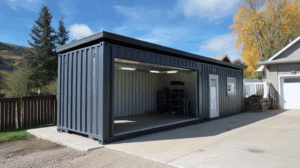Thinking Outside the Box: Innovative Ideas for Constructing a Shipping Container Garage
In recent years, the use of shipping containers in construction has gained immense popularity. These versatile and durable structures have found their way into various architectural projects, from trendy homes to trendy offices. However, one of the most intriguing and practical uses for shipping containers is the construction of a garage.
If you’re looking for a unique and cost-effective way to build a garage on your property, thinking outside the box and considering a shipping container garage might just be the answer. In this blog post, we’ll explore some innovative ideas to give you inspiration for your own container garage project.
1. Designing a Multi-Level Garage
Shipping containers are incredibly stackable, which means you can easily create a multi-level garage by stacking containers on top of each other. This design not only maximizes the use of vertical space but also provides ample storage for cars, tools, and other equipment. By utilizing a staircase or a platform system, you can easily access each level of your garage.
2. Adding a Rooftop Garden
Why limit your garage to just storing vehicles when you can transform it into a functional and aesthetically pleasing space? By adding a rooftop garden to your shipping container garage, you can create a green oasis in the midst of urban living. Install a rainwater collection system, add some plants and seating areas, and you’ll have a beautiful space to relax and unwind.
3. Incorporating Natural Light
One common concern with shipping container structures is the lack of natural light. However, with some innovative design choices, you can overcome this challenge and create a well-lit garage. Consider installing large windows or skylights in strategic locations to maximize the entry of natural light. Not only will this brighten up the space, but it will also save energy by reducing the need for artificial lighting during the day.
4. Going Off-Grid with Solar Power
If you’re passionate about sustainability and reducing your carbon footprint, why not take your shipping container garage off the grid? By installing solar panels on the roof of your garage, you can harness the power of the sun and generate clean, renewable energy. This not only reduces your reliance on traditional power sources but can also save you money on electricity bills in the long run.
5. Creating a Versatile Workspace
A shipping container garage doesn’t have to be limited to just storing vehicles. With some clever design choices, you can transform it into a versatile workspace that serves multiple purposes. Install a workbench, storage cabinets, and proper lighting to create a functional workshop. Add some comfortable seating and a mini-fridge, and you have a fantastic space for hobbies, crafts, or even a home office.
6. Embracing Sustainable Materials
When constructing your shipping container garage, consider using sustainable and eco-friendly materials. Opt for low VOC paints, recycled insulation, and sustainable flooring options to create a healthier and more environmentally friendly space. By making conscious choices during the construction process, you can minimize your impact on the planet while enjoying the benefits of your unique garage.
Conclusion
Thinking outside the box and exploring innovative ideas for constructing a shipping container garage opens up a world of possibilities. From multi-level designs to rooftop gardens, incorporating natural light, going off-grid with solar power, creating versatile workspaces, and embracing sustainable materials, there are countless ways to make your container garage project unique and functional.
Remember, the key to a successful shipping container garage is careful planning and design. Consider your specific needs and goals, consult with professionals if needed, and let your creativity run wild. With the right approach, your shipping container garage can become a standout feature on your property, combining functionality, sustainability, and aesthetic appeal.
Building with Shipping Containers: How to Create a Versatile and Affordable Garage Solution
If you’re in need of a garage space but don’t want to go through the hassle and expense of traditional construction methods, building with shipping containers may just be the solution you’re looking for. Not only are shipping containers readily available and affordable, but they also offer a unique and versatile option for creating a garage space that meets your needs.
The Benefits of Building with Shipping Containers
Affordability
One of the major advantages of using shipping containers for building purposes is their cost-effectiveness. Compared to traditional construction materials, shipping containers are relatively inexpensive, often costing a fraction of the price. This affordability makes them an attractive choice for those on a tight budget.
Durability and Strength
Shipping containers are built to withstand the harshest conditions at sea, making them incredibly durable and strong. Constructed from high-quality steel, they are designed to resist extreme weather, corrosion, and even potential intruders. This durability ensures that your garage solution will stand the test of time and provide a secure space for your vehicles and belongings.
Versatility
Shipping containers offer endless possibilities when it comes to design and customization. They can be easily modified and adapted to suit your specific needs. Whether you’re looking for a single-car garage or a larger space to accommodate multiple vehicles, shipping containers can be stacked, joined, or cut to create the ideal garage layout. Additionally, you can incorporate windows, doors, insulation, and other features to enhance functionality and aesthetics.
Portability
Unlike traditional garages, shipping container structures are portable. If you ever need to relocate, you can simply transport your container garage to the new location. This level of flexibility is particularly advantageous for those who rent their properties or frequently move.
Steps to Building a Shipping Container Garage
Now that you’re aware of the benefits, let’s delve into the steps involved in creating your very own shipping container garage:
1. Planning and Design
Start by determining the size and layout of your desired garage space. Consider the number of vehicles you want to accommodate, as well as any additional storage requirements. Sketch out a preliminary design that includes door and window placements, electrical outlets, and any other specific features you need.
2. Sourcing Containers
Next, you’ll need to find suitable shipping containers. Look for reputable suppliers who offer containers in good condition. Ensure that the containers are structurally sound and free from any major damage or corrosion. Consider purchasing used containers, as they are more cost-effective and environmentally friendly.
3. Site Preparation
Prepare the site where you plan to install your container garage. Clear the area of any obstacles and ensure that the ground is level. If necessary, consult with a professional to ensure proper site preparation and foundation installation.
4. Container Modification
Once you have your containers and a prepared site, it’s time to modify them to fit your garage design. This may involve cutting openings for doors and windows, reinforcing the structure, adding insulation, and installing electrical and plumbing systems. It’s recommended to hire a professional contractor experienced in container modifications to ensure the work is done safely and correctly.
5. Assembly and Finishing Touches
With the modifications complete, it’s time to assemble the containers into your desired garage layout. Stack and join the containers securely, ensuring they are properly aligned and anchored. Once the structure is in place, add finishing touches such as painting, flooring, and any additional features you desire.
6. Utility Connections
Connect the electrical and plumbing systems to your container garage. This may involve hiring licensed professionals to ensure proper installation and compliance with local building codes.
7. Security and Safety Measures
Lastly, don’t forget to prioritize security and safety. Install sturdy locks, security cameras, and an alarm system to protect your vehicles and belongings. Consider adding fire-resistant materials and smoke detectors to enhance safety measures.
Conclusion
Building a garage with shipping containers offers a versatile and affordable solution that can be tailored to your specific needs. With their affordability, durability, and flexibility, shipping containers provide a unique alternative to traditional construction methods. By following the steps outlined above, you can create a functional and stylish garage space that not only protects your vehicles but also adds value to your property. So why wait? Start exploring the possibilities of building with shipping containers and transform your garage dreams into reality!
Revolutionize Your Garage: Transforming Shipping Containers into Functional and Modern Spaces
Are you tired of your cluttered and disorganized garage? Do you dream of having a functional and modern space where you can work on your hobbies or store your belongings? Look no further than shipping containers! These versatile and durable structures have become the latest trend in garage transformations, allowing homeowners to revolutionize their garages into functional and modern spaces. In this blog post, we will explore how you can transform a shipping container into the garage of your dreams.
The Advantages of Shipping Containers
Before we delve into the transformation process, let’s take a moment to understand why shipping containers make an ideal choice for garage conversions.
Durability and Strength
Shipping containers are built to withstand harsh weather conditions, making them incredibly durable and long-lasting. Constructed from steel, they are resistant to corrosion, pests, and fire. This means your transformed garage will provide a safe and secure space for your belongings.
Versatility
Shipping containers come in various sizes, allowing you to choose the one that best suits your needs. Whether you require a small space for your woodworking projects or a larger area for storing your cars, there is a container size for every requirement. Additionally, these containers can be stacked or modified to create multi-level garages, providing even more versatility.
Cost-Effectiveness
Compared to traditional garage renovations, transforming a shipping container is a cost-effective solution. The initial investment in purchasing a container is significantly lower than the cost of constructing a new garage or renovating an existing one. Additionally, the construction process is faster, saving you time and money.
Transforming Your Shipping Container
Now that we understand the advantages of using shipping containers, let’s explore the transformation process. Here are some key steps to revolutionize your garage:
1. Planning and Design
The first step in any transformation project is careful planning and design. Consider how you will use the space and what features you require. Will you be using it as a workshop, storage area, or a combination of both? Sketch out the layout, ensuring you have enough space for your intended purposes.
2. Insulation and Climate Control
To make your shipping container garage comfortable, it is essential to insulate it properly. Insulation will help regulate the temperature inside, keeping it cool in the summer and warm in the winter. Additionally, consider installing climate control systems such as heating and air conditioning to create a comfortable working environment.
3. Electrical and Lighting
Next, you’ll want to install electrical wiring and lighting fixtures. This will ensure you have adequate power supply for your tools and equipment. Plan the placement of electrical outlets and lighting fixtures strategically, keeping in mind your workspace requirements.
4. Flooring and Interior Finishes
Choose a suitable flooring option for your transformed garage. Depending on your needs, you can opt for epoxy coatings, rubber flooring, or even hardwood. Consider the durability and functionality of the flooring material, as it will endure heavy use.
For the interior finishes, you have the freedom to get creative. Paint the walls in your preferred colors, install shelving units or cabinets for storage, and add any other personalized touches that make the space truly your own.
5. Security and Access
Keep your transformed garage secure by installing sturdy doors and windows. Consider security features such as alarm systems, motion sensors, and surveillance cameras for added peace of mind. Additionally, ensure easy access to your garage by creating a pathway or driveway.
The Endless Possibilities
Once your shipping container garage is transformed, the possibilities are endless. Here are some ideas to inspire you:
- Workshop: Set up a fully equipped workshop with workbenches, tool storage, and ample space for your projects.
- Art Studio: Create a bright and inspiring art studio with natural lighting, easels, and storage for your art supplies.
- Home Gym: Build a personal fitness sanctuary with exercise equipment, mirrors, and motivational quotes on the walls.
- Man Cave or She Shed: Design a comfortable retreat where you can relax, entertain, or pursue your hobbies.
- Car Storage: Store your classic cars or recreational vehicles in a secure, climate-controlled environment.
Conclusion
Transforming a shipping container into a functional and modern garage is an exciting project that can revolutionize your space. With their durability, versatility, and cost-effectiveness, shipping containers offer a unique opportunity to create a personalized garage tailored to your specific needs. So, why settle for a cluttered and outdated garage when you can have a modern and functional space that inspires you? Start planning your shipping container garage transformation today!
From Shipping Container to Dream Garage: Unleashing Creativity in your Construction Project
Are you tired of parking your car on the street or squeezing it into a cramped garage space? Do you dream of having a spacious and well-organized garage where you can unleash your creativity and turn it into a personal haven? Look no further than a shipping container conversion project! With a little bit of imagination and some DIY skills, you can transform a simple shipping container into your dream garage.
Embracing Creativity
One of the most exciting aspects of a shipping container conversion project is the opportunity to unleash your creativity. The blank canvas of a shipping container allows you to let your imagination run wild and design a garage that reflects your personality and suits your specific needs.
Whether you’re an avid car enthusiast, a DIYer, or an artist in need of a dedicated workspace, a shipping container garage can be customized to accommodate your unique requirements. You can incorporate features like tool storage, workbenches, shelving units, or even a small office space. The possibilities are endless!
Planning and Design
Before diving into your shipping container conversion project, it’s crucial to plan and design your dream garage. Start by envisioning how you want the space to look and function. Consider factors such as the size of your container, the number of vehicles you need to accommodate, and any additional features you desire.
Sketch out a floor plan that includes designated areas for parking, storage, and workspace. Think about the layout and flow of the garage, ensuring that it’s both practical and aesthetically pleasing. Don’t be afraid to think outside the box and explore innovative storage solutions or unique design elements.
DIY or Professional Help?
Deciding whether to tackle the shipping container conversion project yourself or seek professional help is a crucial step. While a DIY approach can be rewarding and cost-effective, it requires time, effort, and a certain level of expertise. If you’re confident in your construction skills and have the necessary tools, you may choose to embark on the project solo.
However, if you’re unsure about certain aspects or lack the time and resources, hiring professionals specializing in container conversions can be a wise investment. They have the knowledge and experience to handle the structural modifications, electrical installations, and other technical aspects of the project, ensuring a safe and efficient transformation.
Essential Modifications
To transform a shipping container into a functional garage, certain modifications are necessary. These modifications may include:
-
Insulation: Proper insulation is crucial to maintain comfortable temperatures inside the garage. Insulating the walls, ceiling, and floor will help regulate heat and prevent condensation.
-
Lighting: Adequate lighting is essential for a well-functioning garage. Install a combination of natural light sources, such as windows or skylights, and artificial lighting, including LED lights or track lighting, to ensure optimal visibility.
-
Ventilation: Proper ventilation is crucial for air circulation and preventing the buildup of fumes and odors. Consider adding vents or fans to keep the air fresh and clean.
-
Electrical Work: Depending on your needs, you may require electrical outlets, wiring for power tools, or even a charging station for electric vehicles. It’s essential to consult an electrician to ensure proper installation and compliance with safety standards.
Letting Your Personality Shine
Now comes the fun part! Once the essential modifications are complete, it’s time to infuse your personal touch into the garage. Consider the following creative ideas to make your dream garage truly unique:
-
Color Scheme: Choose a color palette that reflects your personality and sets the right ambiance. Bright and vibrant colors can create an energetic atmosphere, while neutral tones provide a calming environment.
-
Wall Decor: Hang up your favorite posters, artwork, or even vintage signs to add character and personality to the space. Consider creating a gallery wall to showcase your interests and hobbies.
-
Flooring: Upgrade the flooring to something more visually appealing and durable, such as epoxy or rubber tiles. You can also incorporate floor mats or rugs to add warmth and comfort.
-
Storage Solutions: Invest in practical and stylish storage solutions to keep your tools, equipment, and supplies organized. Wall-mounted shelves, pegboards, or modular storage systems can maximize space and enhance functionality.
-
Personal Touches: Add personal touches like a mini-fridge for refreshments, a sound system for your favorite tunes, or a comfortable seating area to relax and socialize with fellow enthusiasts.
Conclusion
A shipping container conversion project offers a unique opportunity to unleash your creativity and transform a simple container into your dream garage. With careful planning, innovative design, and the right modifications, you can create a functional and personalized space that reflects your passion and personality.
So, why settle for a mundane garage when you can have a haven that inspires and motivates you? Let your imagination soar and embark on the exciting journey of converting a shipping container into the garage of your dreams!
The Ultimate Guide to Building a Stylish and Sustainable Shipping Container Garage
Introduction
With the increasing popularity of shipping container architecture, more and more people are exploring creative ways to repurpose these versatile structures. One such innovative idea is building a shipping container garage. Not only does it offer a stylish and modern aesthetic, but it also provides a sustainable solution for storage and vehicle protection. In this ultimate guide, we will walk you through the essential steps to create your own stylish and sustainable shipping container garage.
Step 1: Planning and Design
Before embarking on your shipping container garage project, it’s crucial to plan and design the space according to your needs and preferences. Consider the following factors:
-
Size and Layout: Determine the number of containers required based on your storage needs and available space. Plan the layout to optimize functionality and accessibility.
-
Insulation and Ventilation: Create a comfortable environment by insulating the walls and roof of the containers. Proper ventilation is also essential to prevent moisture buildup.
-
Natural Lighting: Incorporate windows or skylights to maximize natural light and reduce the need for artificial lighting during the day.
-
Door Placement: Decide on the best location for the entrance and garage doors to ensure easy access for vehicles and pedestrians.
Step 2: Foundation and Site Preparation
Before installing the shipping containers, it’s crucial to prepare the site and lay a solid foundation. Follow these steps:
-
Site Clearance: Clear the area of any debris or vegetation, ensuring a clean and level surface.
-
Foundation Options: Choose between a concrete slab or pier foundation, depending on your budget and local building regulations.
-
Leveling: Use a laser level or transit to ensure the foundation is perfectly level and ready for the containers.
Step 3: Container Selection and Modification
Selecting the right shipping containers is key to a successful garage project. Consider the following tips:
-
Quality and Condition: Opt for containers in good condition with minimal rust and structural damage.
-
Size and Configuration: Choose containers that match your desired garage dimensions and layout.
-
Cutting and Welding: Consult with a professional to cut and weld the containers as per your design requirements.
-
Insulation and Soundproofing: Insulate the walls and ceiling to regulate temperature and reduce noise.
Step 4: Installation and Assembly
Once you have prepared the site and modified the containers, it’s time to start assembling your shipping container garage. Follow these steps:
-
Container Placement: Use a crane or forklift to carefully position the containers on the foundation.
-
Structural Reinforcement: Weld additional steel beams or columns to strengthen the container structure.
-
Roof Installation: Install a durable and weather-resistant roof system over the containers to protect against the elements.
-
Electrical and Plumbing: If desired, install electrical wiring and plumbing systems as per your garage’s requirements.
Step 5: Interior Finishing and Exterior Enhancements
To give your shipping container garage a stylish and polished look, pay attention to the interior finishing and exterior enhancements:
-
Flooring: Choose a durable and easy-to-maintain flooring option such as polished concrete or epoxy coating.
-
Wall Finishes: Paint the walls with your preferred color or use reclaimed wood panels for a rustic touch.
-
Storage and Shelving: Install shelves or cabinets to optimize storage space and keep the garage organized.
-
Exterior Cladding: Enhance the exterior appearance by adding cladding materials such as wood, metal, or even living walls.
Step 6: Sustainability and Energy Efficiency
To make your shipping container garage sustainable and energy-efficient, consider incorporating the following elements:
-
Rainwater Harvesting: Install a rainwater collection system to utilize water for gardening or vehicle washing.
-
Solar Power: Explore the possibility of installing solar panels on the garage roof to generate renewable energy.
-
Green Roof: Transform your garage roof into a green space by adding a living roof or rooftop garden.
-
Efficient Lighting: Use LED lighting fixtures throughout the garage to minimize energy consumption.
Step 7: Maintenance and Care
To ensure the longevity of your shipping container garage, regular maintenance is essential:
-
Inspect Regularly: Check for any signs of rust, leaks, or structural issues and address them promptly.
-
Repaint and Seal: Repaint the exterior periodically to protect against corrosion and seal any gaps or cracks.
-
Roof Maintenance: Clean the roof regularly and inspect for any damage or wear.
-
Pest Control: Implement measures to prevent pests and rodents from entering the garage.
Conclusion
By following this ultimate guide, you can build a stylish and sustainable shipping container garage that not only provides functional storage but also adds a unique architectural element to your property. Remember to consult with professionals and adhere to local building codes and regulations throughout the process. Get ready to transform your garage into a remarkable and eco-friendly space that reflects your personal style and values.




